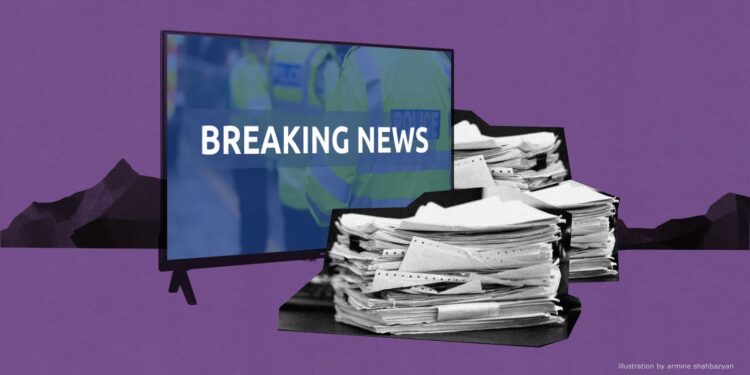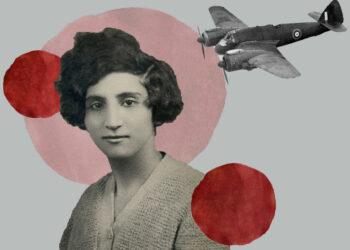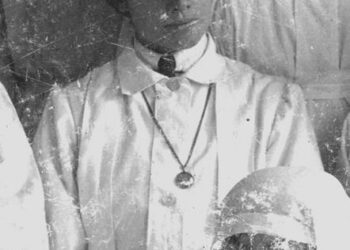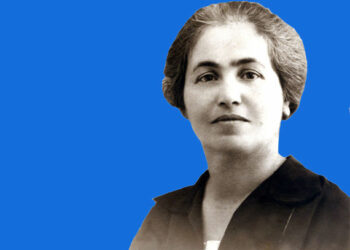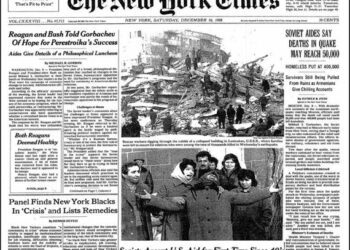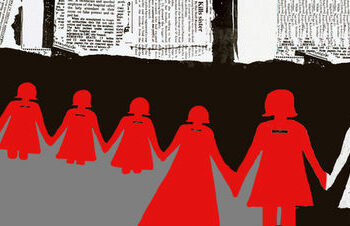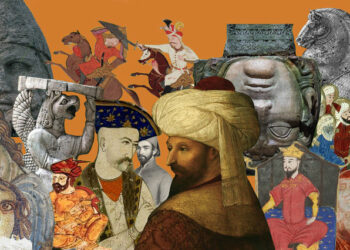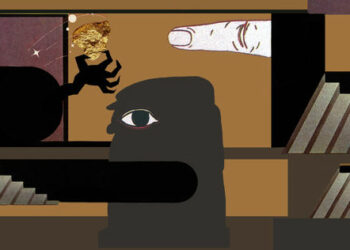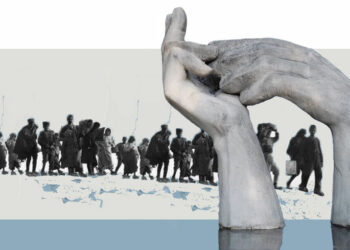Raw & Unfiltered
Marriage Law and Culture: Ottoman Armenians and Women’s Efforts for Reform
Although Armenian women did not directly participate in the public discourse on the family structure and institution of marriage during the 19th to early 20th centuries in the Ottoman Empire, they articulated their concerns against gender inequalities through the voices of the fictional characters they created in their writings.
Armenian Healthcare: Fissures and Fixes
Armenia is slowly inching towards a model of universal healthcare where all citizens will be able to access quality healthcare without falling into financial hardship. While recent developments have definitively set Armenia on that path, much remains to be done to ensure that no one falls through the cracks.
Jack Cracks Open a Window
His scissors his baton, moving like a dancer-magician, Jack seems to induce an otherworldly state. At the end of his intricate symphony, the final product is a manifestation of his vision.
From the Forgotten Pages of History: The Resistance of Louise Aslanian
From Tabriz to Paris, from resistance to a Nazi concentration camp...this is the story of Louise Aslanian, an Armenian woman whose convictions, commitment and words have largely been forgotten.
A Conceptual Gap: The Case of “Western Armenia”
“Western Armenia” as a concept is a crucial component of the Armenian national narrative, mostly in the Diaspora. In this article, Varak Ketsemanian raises some questions regarding the Armenian reality’s understanding of “Western Armenia,” its biases and blind-spots. He suggests refining the ways in which we discuss and represent “Western Armenia” in the 21st century.
Mining and the Protection of Human Rights
Environmental lawyer Artur Grigoryan writes that many countries, including Armenia, often protect the financial interests of mining companies and their shareholders more than the vital human rights of their own citizens.
From Isolation to Inclusion: Children With Special Needs and Their Right to Education
Dismantling decades of prejudice and perceptions about people with disabilities is not an easy task. The inclusion of children with disabilities and special needs in public schools is not an exception, however, attitudes are slowly changing.
Broken Destinies: Diary of a Human Rights Defender
There is no honor in silence. There is no honor when the most vulnerable are subjected to horrifying crimes. Human rights defenders and first responders deal with these cases on a daily basis. Human rights defender Zara Hovhannisyan shares some of her experiences with those whose destinies have been shattered.
Women of Armenia
Almost a third of families living in rural Armenia are female-headed households, a UN Report in 2017 found. These households are more likely to be in extreme poverty than male-headed households. This film by Tsovinar Hakobyan and Joe Nerssessian focuses on the lives of five women from Syunik.
The Life and Times of Eleonora Ter-Parsegova
A leading member of the Georgian Social-Democratic Party at the turn of the 20th century, Eleonora Ter-Parsegova played an important role in the struggle leading up to Georgia’s independence in 1918 and later, after it was sovietized.
Human Rights-Based Approach: Discussions with Decision Makers
In the second of a two-part series on the need for a human rights-based approach to policymaking, human rights activist and researcher Anahit Simonyan talks to a number of ministers and a deputy minister about field specific issues such as poverty, discrimination, health protection and more.
Armenia’s Food Basket: Reality or Battle for Survival?
Over 5500 senior citizens in Armenia who are not eligible to receive a pension, are on welfare. They receive about $50 US per month. Armenia’s minimum food basket, according to the Ministry of Health stands at about $72 US per month. In this photo story, EVN Report tries to understand how these pensioners survive.
Sexual Discourse: Speaking About the Unspeakable
In the public discourse, sex is often seen as being diametrically opposed to almost everything - religion, love, traditional values, even the motherland. With this in mind, many will be shocked to hear that sex does exist in Armenia, Sona Martirosyan writes.
Lessons From an Armenian Diaspora Online Survey
Is it in the mutual interest of Armenia and the diaspora to build a stronger connection with one another? A recent study on Armenia-Diaspora relations sheds new light on perceptions, opportunities and possibilities, one of which might be the creation of a diaspora-portal as a web-based sorting database for establishing connections.
Velvet Revolution: The Moments In-Between
In 2018, the Armenian people were swept up in a nationwide movement that would come to be known as the Velvet Revolution. Photojournalist Eric Grigorian took thousands of photos, documenting and capturing images of ordinary people who came together to achieve the extraordinary. Through his own words, Grigorian tells the story of the revolution and the moments in-between.
Deinstitutionalization: A Policy That Ensures a Child’s Right to Family Life
Over a decade ago, Armenia’s government launched a pilot project called Deinstitutionalization of Orphanages. The initiative, which also sought the creation of a Foster Family program was not successful for many reasons, but mostly because it was never really child-centered. The Ministry of Labor and Social Affairs is set to change that.
A Small Room in a Big Building: Armenia’s Senior Citizens
What happens to those senior citizens in Armenia, who don’t have families who can or want to take care of them? There are only a handful of public and private old age homes, most suffering from lack of funding and poor services.
Overweight, But Malnourished: The Impact of Poor Diets on Armenia’s Children
Lack of awareness, knowledge and education is a contributing factor to malnutrition in Armenian children. Gohar Abrahamyan looks at the research and speaks with parents and experts in the field.
Seeking Perfection
Dr. Aram Hovsepyan examines how people can sometimes fall victim to hidden violence by those closest to them. While this case study is an extreme one that led to implausible results, it highlights the need for education, awareness and most of all, compassion.
The Armenian Orphans of the Genocide: Separation, Reunion, Loss and Sacrifice
Many took the harrowing experience with them to their graves. Others would share only fragments of memories. All of them suffered unimaginable loss. They were the orphans of the Armenian Genocide and their stories must never be forgotten.
How Genocide Survivors Made Yerevan Great
From those who survived the Armenian Genocide to those who moved to Soviet Armenia during the Great Repatriation of the 1940s, Western Armenians contributed to Yerevan’s incredible rise as a major city, turning it into the heart and soul of the Armenian nation.
Human Rights-Based Approach: Discussions with Decision Makers
Is Armenia moving towards the implementation of a human rights-based state and state policy? To find out, Anahit Simonyan interviews Minister of Labor and Social Affairs Zaruhi Batoyan, Minister of Health, Arsen Torosyan, and Deputy Minister of Education, Arevik Anapiosyan.
Armenia’s Trail Builders
With a global demand for outdoor sports increasing and a heightened interest in hiking and guiding in Armenia, several companies are now not only building trails, but possibly rebuilding lives in Armenia’s mountainous landscape.
Tatevik Revazian: Don’t Say It’s Impossible, I Won’t Believe You
Negotiating the complexities of civil aviation aside, Tatevik Revazian, chair of Armenia’s Civil Aviation Committee has had to learn how to negotiate the media landscape, trust less and break down stereotypes.
Protecting the Environment, One Beauty Product at a Time
With the global market value of natural cosmetics steadily rising over the past decade, a number of Armenian companies have begun to create a niche and secure a strong customer base for natural beauty products made in Armenia.
Chronicles of the Old Yerevan Quarter
The destruction of some historic buildings began in the Soviet era. That practice continued after the independence of Armenia. The Old Yerevan Project is meant to restore the architectural heritage of the capital city, however, progress has been slow and controversial.
Water: Armenia’s 21st Century Oil?
Despite a number of legislative and institutional reforms initiated over the past decade, the water sector in Armenia still faces serious challenges with respect to management and protection.
On the Edge of Infertility: The Complexities of Having a Child in Armenia
While rates of infertility have started to come down in Armenia, many couples do face the possibility of never having a child. Not being able to conceive rips some couples apart, while others become stronger as they search for alternative solutions.
Not Armenian Enough
When you are suspended in an in-between place, belonging everywhere and nowhere at the same time, what does it take to prove you are Armenian? A baptismal certificate from an Armenian Church...but even that may not be good enough.
Zabel Yesayan: The Hope for Justice Hidden in a Matchbox
Hidden away in dusty archives, Seda Grigoryan discovered documents from a 1939 Soviet trial that found 20th century writer, literary critic and public figure Zabel Yesayan guilty of crimes she had not committed.
A Beautiful Crime: Soghomon Tehlirian and the Birth of the Concept of Genocide
A survivor of the 1915 Armenian Genocide, Soghomon Tehlirian assassinates Talaat Pasha, the mastermind behind the attempted annihilation of the Armenian nation in Berlin on March 15, 1921. Historian Suren Manukyan examines the repercussions and consequences of that act of revenge.
Armenian Women’s Writing in the Ottoman Empire, Late 19th to Early 20th Centuries
“A male writer is free to be average, but never a female writer.” This is what 19th century writer Srbouhi Dussap told Zabel Yesayan when she announced she wanted to be a writer. Hasmik Khalapyan traces the extraordinary lives of Armenian women writers of the Ottoman Empire.
Shooting to Heal
Vigen Galstyan takes the reader on a journey spanning a century of Armenian women photographers who carved out their own individual spaces and honed a personal vision that spoke to urgent, collective questions, often speaking the unspeakable and approaching the unapproachable.
If I Could Go Back in Time
For International Women’s Day, we asked women what they would tell their younger selves. While their answers weren’t always surprising, they were emblematic of the difficult choices women are often forced to make.
Why Haven’t You Registered? Armenia’s Problem of Illegal Garbage Dumps
An abundance of illegal garbage dumps and legislation that is sometimes unclear about the responsibilities of different governmental bodies with regards to waste management, it’s a wonder Armenia hasn’t drowned in a sea of trash.
Rainbow Hysteria: How LGBT Issues Became a Mainstream Topic of Conversation
LGBT people and issues became a mainstream topic of conversation last year in Armenia, much to the fanfare, or perhaps due to, the former ruling elite, and a public glued to social media.
Reforming the Armenian Mining Sector: Civil Society Stands Up to Be Heard
Mining has a potential to play a significant role in Armenia, however current gaps in legislation and poor monitoring and assessment presents many risks.
Will the Velvet Revolution Shift Armenia’s Dismal Demographic Patterns?
Will Armenia be able to turn the tide on migration? According to a 2015 UN Report, Armenia’s population is projected to decrease to 2.7 million by 2050. Following the Velvet Revolution, however, the ominous demographic situation is starting to show some positive developments.
Sex Education, Stereotypes and Disabilities
Sex continues to be a taboo subject in Armenia. When it comes to sexual relations between individuals with disabilities, the misconceptions and taboos are even greater, writes Kushane Chobanyan.
The Cost of Eminent Domain
A recent ruling by the ECHR has brought up the issue of the proper application of eminent domain once again. While the state has the right to exercise eminent domain, it also has a responsibility to guarantee that the purpose is to benefit society, not narrow business interests.
Surrogacy and Parenthood in Armenia
Couples who have struggled with infertility, sometimes turn to surrogate mothers to have a child of their own. With continuing economic hardship in Armenia, policymakers and health professionals need to address issues in the current legislation that may leave women who choose to become surrogates vulnerable.
The Irreversible Consequence of Indifference
Journalist Gohar Abrahamyan stumbled upon a scuffle on one of the central streets of Yerevan involving an elderly man and his young grandson. While trying to understand the situation, Abrahamyan also uncovered the irreversible consequence of people’s indifference when they witness abuse.
Serving with Honor: Women First Responders
As women in Armenia continue to break stereotypes, they are entering professions usually reserved for men. Kushane Chobanyan spent a day with female first responders and got a peek inside the life of these incredible women.
The Law on Amnesty: Humanitarian Act or Politically Motivated Decision?
Amnesty is practiced in countries where judicial independence is weak or compromised and courts are among the most mistrusted institutions. This year, the ninth amnesty was announced in Armenia. Considering its timing and the stakeholders it affects, some argue that it was politically motivated.
The Spitak Earthquake on the Pages of the New York Times
Three decades after the catastrophic Spitak Earthquake, Hovhannes Nazaretyan takes a look back at how that tragedy was covered by one of America’s most prestigious newspapers.
Palliative Care: The Right to Life with Dignity
Palliative care is an approach that strives to improve the quality of life of patients who are terminally ill; it endeavors to provide a life of dignity. In Armenia, culture, stereotypes and entrenched practices make this approach very difficult to achieve, and instead of helping the patient, often causes them to lose their voice and their dignity.
Her Revolution
This is a film about the Velvet Revolution, which took place in April-May of 2018 in Armenia from the perspective of Anna Hakobyan, the wife of Nikol Pashinyan, the man who led the nationwide movement that drastically changed the country's political landscape. The film portrays the personal side of Pashinyan’s political life and career.
Gyumri 1988 – 2018: Rising Still
Thirty years ago, a devastating earthquake ripped through northern Armenia, killing over 25 thousand people, destroying buildings, decimating entire villages and in its ominous wake, leaving a people traumatized. Today, 30 years on, Gyumri, one of the hardest hit cities, is rising.
Domestic Violence: An Imperfect Law and Enduring Stereotypes
Another case of a woman being killed by her husband has forced Armenian society to speak once again about the one thing it doesn’t like to address - domestic violence.
The Challenges of National Educational Assessments in Armenia
While Armenia has participated in several international comparative educational assessments, and has designed national assessment tools, neither have been implemented properly. Today, more than ever, there is a great need to properly analyze existing data that can inform educational policy making and curriculum development.
The Ambivalence of Shahumyan: Armenia’s Bolshevik Ghost
A prominent Armenian Bolshevik activist and head of the Baku Commune Stepan Shahumyan’s ghost now wanders through his native Caucasus. Armenians have largely forgotten his century-old verbal attacks on nationalism and insistence on internationalist fraternity of peoples, yet his statues remain and streets, villages and towns are named after him in Armenia and Artsakh.
Tigran Gevorgyan: Breaking Stereotypes One Stroke at a Time
Being born with Down Syndrome has not stopped Tigran Gevorgyan from pursuing his dreams. From winning gold medals at the Special Olympics to finding love, Tigran is not only breaking stereotypes, he’s creating a life of joy, fulfillment and meaning.
Chairs…They See No Status
Education is an inalienable right, regardless of circumstances. Juveniles deprived of liberty in Armenia face challenges that include issues with rehabilitation and reintegration, but also with the right to education.
Environmental Protection and Pandora’s Box to Independence
Even after Armenia gained independence from the Soviet Union, it is still reliant on many Soviet-built (sometimes very poorly built) infrastructure that can prove to be dangerous to local communities, flora and fauna, as well as the country’s economy and national security.
Breaking Intergenerational Violence Against Children in Armenia
UNICEF Armenia recently held a conference discussing child abuse in Armenia, a topic that is often not talked about. Based on the Demographic and Health Survey conducted in almost 8000 households in the country, the numbers of children experiencing physical and psychological abuse are quite alarming.
Why Green Policies Are Not Green For Everyone
Cross-border cooperation among environmental groups is imperative to ensure real environmental protection globally. Drawing examples from Armenia and Lebanon, Sophia Manukyan delves into the world of high-stake investments and assistance in heavy metal mining and waste management.
The Two Sides of the Mirror
In this first analytical piece for EVN Report, Yerevan-based psychiatrist Aram Hovsepyan writes about the struggles of people with mental health issues and their caregivers based on field research from his recent visit to the border communities in the Tavush region of Armenia.
Araratian Baccalaureate: Transforming the Future or Creating Selective Education?
The Araratian Baccalaureate, a public-private partnership between the Armenian Government and Ayb Education Foundation launched under the previous administration, came under the spotlight when Education Minister Arayik Harutyunyan questioned the need for “elite” schools and the financial efficacy of the program.
Lilit Makunts: From Civic to Political to Cultural Engagement
It was in her sophomore year at university that Lilit Makunts realized that fighting for justice wasn’t simply a slogan. From her first involvement in a civic initiative to her foray into politics, Makunts has been ‘present’ all along, although perhaps slightly under the public radar. That is, until she was appointed as Armenia’s Minister of Culture on May 12.
This Too Shall Not Pass
Revelations of corruption at the highest levels in recent weeks have shaken many people in Armenia, including the youth who were active during the Velvet Revolution. In this first essay for EVN Report, Nune Harutyunyan writes about her feelings after investigators discovered stolen boxes of supplies meant for soldiers on the frontlines and more.
Is the Study of the Middle Ages Possible in Turkey Today?
The essay attempts to offer several historical and pedagogical responses to the genocide of the Armenian people by suggesting a program on the study of the Middle Ages of Turkey, one that would entail the study of the three mediaeval epic tales that were forged during the Middle Ages on Anatolian soil.
Amulsar: Gold Over Water?
The Amulsar gold mine, owned and operated by Lydian Armenia, is one of the most controversial projects in recent years in Armenia. Over the past weekend, activists from Yerevan and elsewhere traveled to the province of Vayots Dzor to raise awareness about the potential danger the mine poses to the environment.
The Stories Behind the Story of a Revolution
A series of extraordinary events in early spring of 2018 that came to be known as the Velvet Revolution fundamentally changed Armenia’s political landscape. EVN Report’s Maria Titizian reflects on some of her personal experiences during those heady days.
Armenian Futurists of the Past
Arpine Haroyan looks back at how an avant-garde art movement called Futurism impacted the work of a number of young Armenian intellectuals in Constantinople, Tbilisi and Yerevan at the turn of the 20th century.
State Governance Failures in Mining and Lessons for Armenia’s Future
In his first piece for EVN Report. Alen Amirkhanian writes about the current state of the mining industry in Armenia. He argues that mining governance, from decision-making process on granting mining licenses, monitoring performance to ensuring compliance with laws and standards, is defective and in need of determined reform.
The Symbols of the First Republic of Armenia
After centuries of being stateless, Armenia declared independence on May 28, 1918. Institutions needed to be built from the ground up including the creation of the symbols of statehood. Here are the stories behind those national symbols as remembered by the First Republic's last Prime Minister Simon Vratsian.
Records, Discourses and Memories: Narrating the First Republic
As Armenians prepare to mark the centennial of the First Armenian Republic (1918-1920), Varak Ketsemanian writes that there seems to be little consensus regarding its true meaning, its contested legacy and the various forms through which it should be commemorated.
Yerevan Time and the Burden of Victory
As a participant and observer in every protest starting with the Karabakh Movement in 1988, Lusine Hovhannisyan writes that while Nikol Pashinyan gifted Armenians victory in 2018, the people now find themselves nervous about every decision, every appointment, every opinion being expressed.
Portraits From Republic Square
Photojournalist Eric Grigorian's series of portraits from Republic Square where thousands gathered in protest as Yerevan enters the seventh day of mass rallies, protests and innumerable acts of civil disobedience.
1988: Thoughts Spoken Aloud
Vardges Baghryan, a journalist from Artsakh recounts his personal memories from the Karabakh Movement and the war. He recalls the siege on the village of Karintak and how the future freedom and independence of the people of Artsakh was forged.
Is This What You Wanted?
President Serzh Sargsyan’s second and final term in office ends on April 9. It is almost certain that he will be elected as the country’s new prime minister thereby prolonging his power. EVN Report looks back at the Constitutional amendments that led to this situation and a new military-patriotic educational doctrine that is set to pass in parliament.
The “Hunger Artist” Among Us
A perceived absence of agency has led to growing public indifference in Armenia. When those who do take a stand, regardless of their tactics, are left to stand alone, more questions than answers surface. From the recent sentencing of radical opposition activists, to sit-ins and hunger strikes Opera Square to continuing impunity, everyone seems to be forgetting to ask, why?
A Country That Changed Hands: A Conversation About Us and Us
Lusine Hovhannisyan was a witness and participant in the Karabakh Movement. Thirty years later, she had the chance to meet with someone who was on the opposite side of the barricades - a Soviet official who had tried to infiltrate the ranks of the demonstrators.
Not What But Why: The Nature of Patriarchy
Gender discrimination is a deeply cultural problem, Rafik Santrosyan writes. The incident last month in Yerevan City Hall where a group of men beat a woman councilor highlight how patriarchal relations, toxic masculinity and internalized misogyny have influenced the public discourse.
A Hidden Minority: Children With Disabilities in Armenia
“There are no invalids in the USSR!” This much heard expression exemplifies how people with disabilities were stigmatized in the Soviet Union. How pervasive is the exclusion of people with disabilities in post-Soviet Armenia? Anais Bayrakdarian talks to experts working in the field and writes that the true measure of any society can be found in how it treats its most vulnerable.
Between Honor and Shame: Understanding Corruption in Armenia’s Political Culture
Is corruption inherent to the post-Soviet Armenian political culture, and if so, does this make the political culture of Armenia incompatible with democratic values? Dr. Nerses Kopalyan examines how conflictual matters that should be resolved in the public sphere are almost always resolved within the cultural rules of the private sphere.
Bourj Hammoud and the Prodigal Daughter
A native of Bourj Hammoud bids farewell to her hometown following an attack on writer Raffi Doudaklian in what appears to have been an attempt to silence his words. In this deeply personal essay, Roubina Margossian reflects on her complicated relationship with the town.
2008: Post-Election Armenia in Images
On March 1, 2008, police units move in to put an end to ongoing protests disputing the results of the February 19, Presidential Elections in Armenia. In the aftermath ten people are dead, hundreds were injured. The reality before and after March 1st as seen through the lenses of the members of the 4Plus photo collective.
There is Now a Statue of a Dove in Sumgait
Deciding never to use the word Genocide and then coming face-to-face with it again in a new context; between reading biographies of the victims of the Sumgait Pogrom over and over again and the urge to see who now occupies the homes of the Armenians of Baku and Sumgait, writer Lusine Hovhannesyan unexpectedly discovers a common yet obvious thread.
My “Karabakh Movement”
Journalist Lusine Hovhannesyan recounts her personal memories as a university student during the first days of the Karabakh Movement. She writes, “We became beautiful and fell in love easily like young men and women living out their last days at the barricades and we sang songs of resilience in the streets of Yerevan.”
What is “Armenian” in Armenian Identity?
In the last 100 years, there have been hierarchies of identity and canonical approaches to definitions of "Armenian," especially as articulated, rationalized and promoted by elites, institutions and political parties in the Diaspora and in Armenia. This essay is not a study of identity per se, but about one of the aspects of identity – the “Armenian” bit of it.
1988
In this exceptionally honest and candid article, Gevorg Ter-Gabrielyan writes about his impressions from the first few months of the Karabakh Movement 30 years ago, with words he did not have nor could find at the time.
Rethinking the Discourse on Armenian Diaspora: Language(s), Culture(s), Affiliation(s)
In this first essay for EVN Report, Dr. Vahe Sahakyan of the University of Michigan seeks to address the issue of Armenian diaspora leadership by examining it in theoretical and comparative perspective. He asks, who are the diaspora leaders, and can they have multiple geographical or cultural identities and yet remain ethnically “unmixed?”
Addressing the HPV Vaccine Hysteria
Over the course of the next two years, 20,000 13-year-old girls in Armenia are to receive the HPV vaccine free of charge before the Ministry of Health makes a decision for permanent implementation of the vaccine into the national plan.
On the Edge of Life and Death: 18 Hours Under the Ruins
When a massive earthquake rocked northern Armenia in 1988, EVN Report’s Vahram Ter-Matevosyan was a fifth grade student in Gyumri. In this personal essay, he recounts his experience of being trapped beneath the ruins of his school for 18 harrowing hours.
Heart First
In this poignant essay, Lalai Manjikian writes about the frantic rhythm of managing a career and motherhood. The transition to motherhood, she writes, is not necessarily easy and nor is it the aestheticized perfect pastel images on social media. It is messy, painful, and exhausting, yet, interspersed with pockets of unimaginable heart-expanding joy.
Could Armenians Remain a Global Nation with a Broken Homeland?
Even as “Global Armenians” seem to be thriving around the world, they don’t appear to be thriving in the Republic of Armenia. Global Armenians, like the ocean-crisscrossing Armenian merchants of the 16th-18th centuries, contributed to vibrant Armenian communities around the globe, “preserving a nation is not the same as preserving a community,” writes Dr. Hratch Tchilingirian.
ECLIPSE
Armenia’s Ministry of Culture shut down an exhibit entitled ECLIPSE at the Tumanyan House Museum in Yerevan stating that it was ‘politicized’. Since the public no longer has the opportunity to physically go and see the exhibit, Narine Tukhikyan, the director of the Tumanyan House Museum, provided EVN Report with all the curated artifacts so that it could live on virtually.
Three Apples: The Relic
After decades of moving from city to city, writer and journalist Paul Chaderjian ends up with a relic that has no place in his two suitcases of mere essentials. A personal story that comes full circle from orphanages in Aleppo to civil war Beirut to Fresno and New York to Doha and Istanbul.
Eli and Gor
Journalist, activist and cartoonist Lucine Kasbarian's political cartoon "Eli and Gor, A Cross-cultural Parallel" is a reflection of her desire to make incisive and humorous commentaries about the Armenian condition.
Memories of the Future
An experimental film and an introspective by Seda Grigoryan where her experiences of covering the Daredevils of Sassoun saga merge with impressions and sentiments from a visit to Western Armenia.
Armenians Online or How I Learned to Stop Worrying and Embraced Criticism
Comedian and co-founder of ArmComedy Sergey Sargsyan offers some interesting advice about what to do when confronted with hateful comments on social media.
An Armenian-American Diplomat in Yerevan
How does one navigate identities? Serving as the Deputy Chief of the Political/Economic Section at the U.S. Embassy in Yerevan, Ruben Harutunian writes that it was a unique opportunity to return to his hometown to support the effort of building ever-stronger ties between the United States and Armenia.
A Corner Frozen in Time
The story of Gayane Arevshatyan’s home-restaurant began twenty years ago, after a tragedy that radically changed her life. It was the Armenia of the 1990s - the cold and dark years. The country had survived a devastating earthquake, the Karabakh War, the disintegration of the Soviet Union, blockade, an energy crisis...In a matter of years, lives and narratives had turned upside down.
The Armenian Identity and the Armenian State
Nareg Seferian discusses his experiences dealing with ethno-national identity, the current situation with the Armenian identity around the world, and how it plays out vis-à-vis the Republic of Armenia.
The Last Bard of Leninakan
Jag Bambir, one of Armenia’s most beloved musicians, is an early pioneer of the rock and roll movement in the former Soviet Union. In this piece, Raffi Meneshian reviews a recent concert Jag gave in Gyumri in April where he presented his latest creation – Treaton.
Russian Armenians: Navigating Identity
In the traditional Diaspora narrative, American-Armenian, Syrian-Armenian and many other options exist, but Russian-Armenian has never been on the list according to journalist Grigor Atanesian who was born and raised in Saint Petersburg. He says that you’re either Russian or Armenian. "Visiting Armenia, we were the Russian kids who found love in a hopeless place," he writes.
Where Have the Women Gone?
The voices of women writers occupy a small space in the Armenian literary canon. They are for the most part absent in literature textbooks in Armenia with the exception of a few women writers, mentioned only in passing. Contemporary women writers, translators and educators answer the question: Where have the women gone?
Impunity for Domestic Violence in Armenia’s Criminal Justice System
Domestic violence is a critical issue facing women globally, and women in Armenia are not immune from it. In this piece, Ani Jilozian of the Women's Support Center based in Yerevan highlights the current situation in Armenia and the importance of passing legislation on domestic violence.
Reimagining Memory
Every year the Foundation for the Preservation of Wildlife and Cultural Assets organizes the collection of flowers laid at the Genocide Memorial on April 24. The flowers are then recycled into handmade paper.
The Intellectual Crisis of the Armenian Reality
Varak Ketsemanian presents a critical analysis of Sona B. Dadoyan’s work, “2015, The Armenian Condition in Hindsight and Foresight: A Discourse,” a timely and critical piece of scholarship that sheds light on the intellectual crisis of the 21st century Armenian reality.
Zoryan Institute: Serving the Cause of Scholarship
This year, the Zoryan Institute for Contemporary Research and Documentation marks its 35th anniversary. The Institute's core concept is to serve the cause of scholarship and public awareness relating to issues of universal human rights, genocide and diaspora-homeland relations.
Aurora Prize for Awakening Humanity 2017
Awarded on behalf of the survivors of the Armenian Genocide, co-founders of the initiative Ruben Vardanyan and Noubar Afeyan announced the nominees for the Aurora Prize for Awakening Humanity 2017 in Yerevan on April 24.
102 Years On: The Transformational Power of Hope
We need a social reformation to find the path to hope and the transformation starts with ourselves. Ahead of the 102nd anniversary of the Armenian Genocide, Maria Titizian writes about the importance of having hope.
The Go Between: A Challenge
In this post-Election essay, Paul Chaderjian reflects on how a group of his peers, men and women from all walks of life, made a collective effort on April 2 to serve as citizen observers in the homeland.
Armenia, Azerbaijan and the War on Information
Security expert Samvel Martirosyan writes that Armenia and Azerbaijan are not only waging war on the battlefield but in the media, through social networks, on academic platforms - all platforms where it is possible to disseminate information and propaganda.
My Conquest of Armenian Identity
Irony lurks in every corner of Armenia, writes Sergey Sargsyan, the "Russian boy" who went into the voting booth and got himself a neat Armenian accent.
The Go Between and Ancient Voices that Beckon
In this moving piece, Paul Chaderjian writes about belonging and identity, of hovering in a ‘Go Between’ space, suspended between two worlds and how unexpected encounters make connecting to the concept of home a reality.
Bread and Fire: Change Starts Within Each of Us
Arto Vaun writes about the passing of Artur Sargsyan, the man who broke through heavy police barricades to deliver food to the Sasna Dzrer and in doing so, became something of a legend.
Arshaluys: A New Dawn in Berd
Why is Arshaluys Amsih, originally from Lebanon, spending two years in the border town of Berd? She is one of the growing numbers of Teach for Armenia Fellows teaching disadvantaged children in Armenia’s underserved regional schools.

